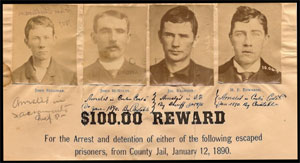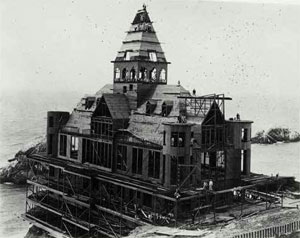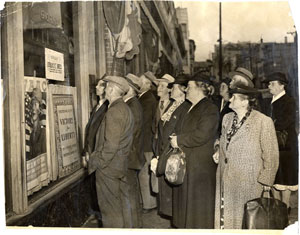Timeline
Special thanks to Timlines.ws for the local event listings.| Traverso Events | Year | Local Bay Area Events |
|---|---|---|
| Location of 1050 Battery Street is originally a part of the Port of San Francisco at North Beach. It is believed that many ships arriving to the port in 1849 were immediately abandoned by sailors and passengers heading for the Gold Country near Sacramento. Some ships became leased as storehouses. More about the Philip Hone at the Maritime Heritage Project (scroll down about half-way.) About 1851, Yerba Buena Cove began to be built up with landfill covering the ships and wharves. | 1849 Population >1,000 |
 Philip Hone arrived in the port of San Francisco in area known as Law's or Buckelew's Wharf |
| 1654 Dupont purchased by Vittorio in 1908 | 1852 |
 Rev. Fielding Spotts, First Colored Baptist Church of San Francisco established at 1654 Dupont Street in 1852-1854 |
| Vittorio Born in Italy | 1866
|
Mark Twain works for the San Francisco Dramatic Chronicle |
| Luisa Born in Italy | 1875 | San Francisco Board of Supervisors passes an ordinance making it a misdemeanor to keep or frequent opium dens |
Vittorio immigrates to America |
1888 |
Iron and wood steamship City of Chester sinks in San Francisco Bay, killing 16 people |
| Luisa immigrates to America | 1890 Population 233,959 |
 King David Kalakaua of Hawaii visits San Francisco Dies at Palace Hotel in 1891 |
| Vittorio and Luisa meet | 1890 Population 298,997 |
 1890 Wanted Poster issued by the San Francisco Sheriff |
| 1891 |  Scow Schooner ALMA built. No scow schooners save Alma are known to survive afloat in the United States. She is now a National Historic Landmark (#75000179) at Hyde Street Pier. |
|
| 1892 | Sierra Club is founded by John Muir | |
| 1893 |  M. H. de Young, a San Francisco local, envisioned a world fair - California Midwinter International Exposition |
|
| Vittorio and Luisa marry | 1894 | Infamous Pullman Strike of 250,000 American Railway Union members in 27 states, led by Eugene V. Debs, cuts the San Francisco Bay Area off from physical correspondence. No trains, no mail, no communication. 19th Century Bicycling: Rubber was the Dark Secret |
| Bill born in San Francisco | 1895 |  2nd Cliff House built |
| Family moves to Lake County CA Vittorio working at Great Western Quicksilver Mine |
 Lefty O’Doul, baseball star, born in Butchertown neighborhood south of Market |
|
| Vic born in Lake County | 1898 | The Spanish-American War bring troops to San Francisco Ferry Building built |
| Family moves back to San Francisco | 1900-1904 Population 342,782 |
Plague in San Francisco |
| Vittorio purchases 491 Greenwich Street | 1901 | More than 1,000 saloon keepers and another 1,000 bartenders in San Francisco, who all influenced political discussions in their saloons Formation of the Union Labor Party |
| Jack born in San Francisco | 1902 | Ansel Adams, American photographer, born in San Francisco View photos of Golden Gate taken by Adams |
| 439 Greenwich Street Vittorio manages grocery/liquor store |
1902-1910 | |
| 1903 | The Commonwealth Club of California is founded by San Francisco Chronicle editorial writer Edward F. Adams | |
| 1904 |  5-story building completed for the Folger Coffee Co. It survived the 1906 earthquake due to wooden piles driven 40 feet into the bay fill below. |
|
| 1905 | Frank W. Epperson invents the Popsicle on a cold night in San Francisco | |
| Vittorio moves family across the bay Returns to rebuild 491 Greenwich Street |
1906 | April 18, 1906 Earthquake and Fire |
| 1907 | 2nd Plague in San Francisco |
|
Vittorio purchases 1654 Dupont Street ( next door to 491 Greenwich) |
1908 | FBI organizes | San Francisco FBI History |
| Vittorio Naturalized as US Citizen Vic reestablishes ownership of 1654 Dupont Street |
1909 | John Muir leads the movement to save the Hetch Hetchy Valley from despoliation at the hands of the City and County of San Francisco |
| Vittorio votes for first time Lodgers fill Telegraph Hill Hotel |
1910 Population 461,912 |
Angel Island opens and becomes point of entry into US on west coast 1910 Election Ballot Propositions Buffalo Bill’s Wild West and Pawnee Bill’s Far East combined shows arrived in San Francisco. They set up on 8 acres at 12th and Market with a big arena and 22 tents. This was part of Col. William Cody’s farewell tour. |
| Vittorio continues rebuilding 491 Greenwich Vittorio goes to Ogden, Utah and New York, NY during same trip |
1911 | California's special election held to vote on Senate Constitutional Amendment no. 8 granting suffrage to women |
| 1912 | Movement to create a Greater San Francisco in which southern Marin County, the part of Alameda County which includes Oakland, Piedmont and Berkeley, and northern San Mateo County from San Bruno northwards would have become outer Boroughs of San Francisco, with the City and County of San Francisco functioning as Manhattan, based on the New York City model. East Bay opposition defeated the San Francisco expansion plan in the California legislature, and later attempts at San Francisco Bay Area metropolitan area consolidation in 1917, 1923, and 1928 also failed to be implemented. Titanic sinks |
|
| 1913 | California Red Light Abatement Act Raker Bill granted the city of San Francisco right to dam Hetch Hetchy Valley as a reservoir; and the unfulfilled right of municipalized electricity for the city |
|
| 1914 | In Los Angeles, a 32,000-square-foot public market called the White Arcade, on the corner of Pico and Main, became the precursor to supermarkets. | |
| Bill is Chief Yeoman in the Navy | 1915 | Panama–Pacific Exposition |
| 1916 |
First self-service grocery store, Piggly Wiggly, opens |
|
|
1918-1919 |
Spanish Flu in San Francisco on September 23, 1918, when Edward Wagner of Eddy Street reportedly brought the flu by train from Chicago. Within the next three weeks, there were more than 500 cases and nearly 50 deaths in the city. SF Chronicle |
| Before 1920 | American women gained their right to vote in 1920. But in California, women had already won the right to vote in 1911, nearly a decade earlier. |
|
Bill passes bar exam |
1920 Population 506,676 |
New York-to-San Francisco air mail service was inaugurated. US postal planes began flying across the country, but these flights took place only in daylight because pilots relied on visual landmarks to navigate. |
| Company moves to 506 Washington Street | 1922-1924 | |
| V. Traverso Co. Established | 1922 |  Herbert Fleishhacker purchases from the Spring Valley Water Company a 30-acre site near the ocean to build San Francisco Zoo |
| 1923 | Steinhart Aquarium in Golden Gate Park opens | |
| Company moves to 441 Washington Street | 1924-1931 | |
| 1924 | Glendale’s Ye Market Place fused the superservice gas station with the public market, combining food providers with a large parking lot. | |
| 1925 | Frank Geiss helped organize the Cross City Race (begun in 1915); later became full-time manager of event that became the "Bay to Breakers" | |
| 1926 | Construction began on the $5 million War Memorial Opera House | |
| 1927 | Bank of Italy became a National Bank; California’s laws prohibiting branch banking changed and A.P. Giannini consolidated his banking properties into the Bank of America of California | |
| Rainbow Stores organizes | 1928 Population >506,676 |
Creation of California Hockey League |
| 1929 | Completion of Great Highway and Ocean Beach Esplanade | |
| Company moves to 170 Pacific Street | 1931-1944 Population 634,394 |
|
| Company gets one of first beer deliveries in San Francisco Vittorio passes away |
1933 | End of prohibition San Francisco Ballet founded Coit Tower built |
| 1934 | West Coast Waterfront Strike | |
| 1935 | San Francisco Museum of Art opens in Veterans Memorial Building City College established |
|
| 1936 | San Francisco–Oakland Bay opens |
|
| Luisa Passes away | 1937 | Golden Gate Bridge opens |
| Company establishes Rainbow Food Stores First Annual Banquet and Picnic |
1939 | Golden Gate Exposition held on Treasure Island Alcatraz becomes federal maximum security prison |
| 1941 Population 634,536 |
Attack on Pearl Harbor |
|
| Bill appointed by Governor Warren as Judge of the Municipal Court |
1943 | SF’s Fillmore merchants voted to melt down the 14 cast-iron arches that spanned Fillmore from Fulton to California streets to support the war effort |
| Company purchases 1050 Battery Street | 1944-1964 | |
| 1945 |  Traverso Archives United Nations Charter signed in San Francisco |
|
| 1946 | Actress Mitzi Gaynor begins career in San Francisco Civic Light Opera Company’s “Roberta" | |
| V. Traverso Co. Incorporates | 1947 |  Under SF Mayor Roger Lapham the cable car system was slated to be junked until Friedel Klussmann led a group of women to preserve the system won a battle to preserve half the system. She formed the Citizens Committee to Save Cable Cars and stopped the city from junking the whole system. |
| Corporation meets monthly through 1965 | 1948 | LP record arrives on a vinyl disk; "Beat Generation" begins (more about record stores in San Francisco) |
| Warehousemen's strike begins in June and a settlement is reached in October | 1949 | Grace Marchant began her garden project on Telegraph Hill; daughter Valetta carried on project |
Bill appointed Presiding Judge of the Superior Court |
1950 Population 775,357 |
 The noisy pile driver known as "Alfred the Monster" was brought into SF to build the foundations of the Bank of America building by civil engineer Charles Graff. Alfred was buried at sea upon completion of the job. |
| Jack assumes management of V. Traverso Co. | 1951 | The Highway 101 freeway opened. In San Francisco it replaced Bayshore Boulevard as the main north south link to the city. |
| Directors discussed opening 2nd warehouse in Watsonville-Salinas area | 1952 | Municipal Railway fares up to 15 cents leading to decline in ridership and 20% increase in automobile traffic downtown (Muni History) |
| V. Traverso Co. increases company's welfare plan to include benefits to office staff and directors (warehousemen and teamsters were already receiving benefits) | 1953 | SF Board of Education decided to require newly hired teachers to sign statements that they are not members of the Communist Party in addition to taking the Levering loyalty oath required by the state Constitution |
| Directors dealt with Robinson-Patman Act issues, coffee market prices, delinquent accounts, increases in freight charges, and expanding the operations | 1954 | Largest store in the Safeway chain opened at Duboce and Market in SF |
| Expansion of operations still under consideration including new site, single floor, additional land to expand in future | 1955 | AFL grocery clerks struck against 400-members of Retail Grocers Association and picketed 2 stores in SF. Negotiations broke down over union demands for $3 per week wage increase. Employer’s lockout closed at least 100 stores |
| For last few years, directors focused on delinquent accounts | 1956 | San Francisco’s cable car system reduced from 6 to 3 lines; last car on 70-year-old Washington-Jackson line rolled into the barn |
| Directors moved from expansion discussions to making improvements including new motor equipment and pallet racks | 1957 | C.Y. Lee authored novel "The Flower Drum Song," a story of San Francisco’s Chinatown; inspiring Rogers and Hammerstein musical |
Following Vic's death, son Victor W. Traverso joins board |
1958 | New York Giants move to San Francisco |
| California legislation places tax on cigarettes Company purchases a stamping machine |
1959 | Candlestick Park, first SF stadium, constructed for Giants |
| Corporation resolved to meet new permit guidelines in connection with alcohol and cigarette | 1960 Population 740,316 |
Demolition of Fontana spaghetti factory (image) on North Point Street, replaced by twin 17-story towers, the old warehouse, built between 1868-1870, first used as woolen mill then converted to spaghetti factory around the turn of the century |
| 1960 fiscal year produced $40,000 in additional earnings (a current value of $328,478); directors approved bonuses for themselves (given salaries for year were below average) and declared a dividend of 15¢ per share of of stock held by stockholders | 1961 | Tony Bennett, starring at Venetian Room, SF Fairmont Hotel, made 1st solo public performance of “I Left My Heart in San Francisco" |
| Minutes (February - November) missing from Traverso Archives | 1962 |  North Beach residents reading bulletin at Giornale L'Italia announcing unconditional surrender of Italy L’Italia building, Stockton and Green, fell under wrecker’s ball; 45-year-old building housed largest Italian-language newspaper this side of New York; newspaper, founded in 1886, merged with La Voce Popolo in 1939; moved to new quarters |
| Voted a dividend of 50¢ per share of stock paid to stock holders to be paid January 1964; minutes (February - December) missing from Traverso Archives (Jack experiencing health issues this year) | 1963 |  Folger Building | National Register #96000679 Proctor & Gamble Company purchased SF-based Folger Coffee; 1994 P&G closed Folger's plant; brand's last presence in the Bay Area |
| Directors begin winding up V. Traverso Co.; by October business closed and assets distributed; family continues to own 1050 Battery Street, 491 Greenwich Street and 1654 Grant Avenue | 1964 | Scottish Rite Masonic Center completed at 2850 19th Ave |
| Bill retires from bench | 1965 |  “Boss of the Bay” KYA presents Rolling Stones, Byrds, Beau Brummels, Paul Revere and Raiders, and Vejtables, at Civic Auditorium kicking off a five-year influx of music, hippies, drugs, and "free-love" |

